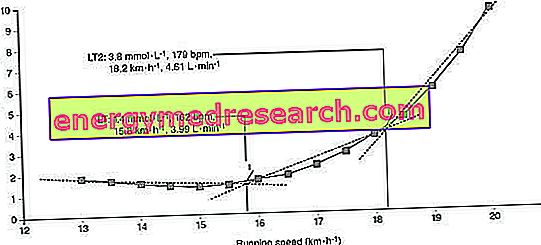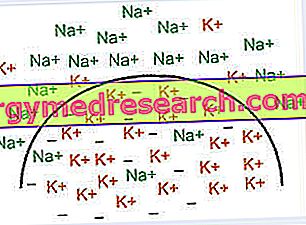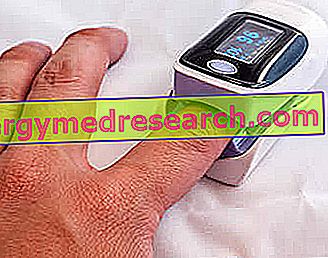The VAP test (Vertical Automatic Profile - from the Vertical Auto Profile) is an exam aimed at the dosage of blood lipids, including: cholesterol, lipoproteins and other fats. The name "VAP test" was coined by the private cardio diagnostics company "Atherothec" to identify the relative direct measurement method
Category blood analysis
Generality What is it, but above all, why is lactic acid produced by cells? Lactic acid (C 3 H 6 O 3 ) is a weak acid that is produced by cells that extract energy through anaerobic glycolysis, therefore by breaking down glucose in the absence of oxygen. To be precise, anaerobic glycolysis is an essential process that precedes the Krebs cycle and therefore constitutes a fundamental step in cellular respiration; therefore, why sometimes anaerobic glycolysis reaches the production of lactic acid instead of continuing cellular respiration with pyruvate
Key points Definition of hyponatremia Blood sodium concentration <135 mmol / L Classification and causes of hyponatremia Hypertonic hyponatremia: caused by hyperglycemia Isotonic hyponatremia or pseudohyponatremia: caused by an exaggerated increase in lipids and / or plasma proteins Hypotonic hyponatremia: caused by the increase in the hormone ADH → water retention → hyponatremia Hypervolemic hyponatremia: caused by congestive heart failure, liver failure, cirrhosis, kidney disease Euvolemic hyponatremia: caused by inappropriate hypersecretion syndrome of the antidiuretic hormone (SIADH), hy
Low sodium in the blood Hyponatremia is a clinical condition in which the concentration of sodium in the blood is lower than normal. In physiological conditions, the concentration of sodium in the blood (natriemia or sodium) is maintained at levels between 135 and 145 mmol / L. We speak of hyponatremia (or hyponatremia) when this value falls below 135 mmol / L
Definition of thrombocytopenia In the medical field, platelet suppression is defined as the occurrence of circulating platelets less than 150, 000 units per mm3 of blood, detected on a blood count carried out at least with two different anticoagulants. The thrombocytopenia therefore outlines a parameter indicative of blood coagulation capacity: in general, the quantity defined as "normal" (or physiological) of platelets in the blood is between 150, 000 and 400, 000 units per mm3
Premise So far we have given the general definition of thrombocytopenia, focusing on the related pathological consequences and on the main causes: in this article we will describe in detail the platelet count gravidic and that induced by pharmacological substances. Finally, we will briefly analyze effective therapies to combat this problem once and for all
Scroll down the page to read the summary table on thrombocytopenia Plateletopenia or thrombocytopenia Indicative parameter of blood coagulative capacity: circulating platelets <150, 000 / mm3 Physiological amount of platelets in the blood 150, 000-400, 000 plates / mm3 Probability of spontaneous bleeding Plateletopenia: 50, 000-150, 000 platelets / mm3 → hemorrhage can occur following trauma / surgery Plateletopenia: 20, 000-30, 000 platelets / mm3 → increases the risk of spontaneous bleeding Plateletopenia: <10, 000 platelets / mm3 → ascertained and worrying bleeding Severe thrombocytope
Generality Pulse oximetry is a particular method, indirect and non-invasive, which allows the measurement of oxygen saturation in the patient's blood ; more in detail, this examination allows to determine the oxygen saturation of the hemoglobin present in the arterial blood (often indicated with the abbreviation " SpO2 ")
Generality The oximeter is a tool that allows you to measure and monitor the degree of oxygen saturation . More in detail, the oximeter allows to evaluate the oxygen saturation of the hemoglobin present in the peripheral arterial blood (defined with the abbreviation " SpO2 ") and, at the same time, it also allows to measure the heart rate of the same patient
Generality Oxygen saturation is a blood index that reflects the percentage of hemoglobin saturated with oxygen compared to the total amount of hemoglobin present in the blood. Under normal conditions, during the passage in the lungs, the red blood cells rich in hemoglobin are charged or saturated with oxygen, which will then be transported and transferred to the various tissues of the body
By Dr. Luca Franzon Introduction I think it is right for a fitness professional to be able to evaluate the state of health of the users, and to do so knowing how to read the reports of the blood tests that fitness practitioners often carry with them when they are gym membership. It is clear that the instructor is not a doctor, and that he absolutely must not make a diagnosis or allow himself to advise strange alchemies which would then prove to be unhealthy for those attending the gym







